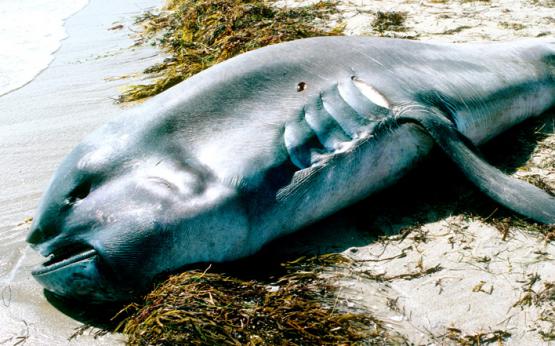What is Megamouth?
Megamouth sharks - Megachasma pelagios - are one of rarest types of shark in the world despite being large, growing to at least 5.5m in length.
The first specimen was discovered in 1976. To date, only 50 examples of this shark have been found.

- Megamouth III beached on Mandurah beach
- Photo by WA Museum
- Photo copyright of WA Museum
Megamouth sharks spend daylight hours near the edge of the continental shelf, swimming slowly at depths of 150 m or deeper. At night time it rises close to the surface to feed on small shrimp that form part of the plankton.
They are one of only three species of sharks that feed on plankton (planktivorous). They probably swim along with their mouth open, filtering plankton from the water as it passes through their gills. The other two filter-feeding shark species are whale sharks and basking sharks. Like these other filter-feeding sharks, megamouth sharks only have small teeth. Megamouth sharks are also able to thrust out their jaws (called protrusible jaws).
Megamouth sharks have soft bodies with large oily livers, flabby muscles and skeletons that are poorly calcified. These features probably help megamouth sharks to swim very slowly without sinking.
Little is known about how these sharks reproduce but they probably give birth to live young which have fed on unfertilised eggs in their mothers’ uterus. This is known as oophagy.
DNA studies suggest that megamouth sharks are the most primitive of sharks of the Order Lamniformes, the group which includes white pointer, mako, basking and grey nurse sharks.
Finding Megamouth specimens
- The first megamouth (Megamouth I) was captured at 165 m when its teeth became caught in a parachute-like drogue being used to anchor a large research vessel at sea. This Hawaiian specimen was probably intrigued by the fine fabric of the parachute and decided to taste it. Its large mouth, lined with many rows of small sharp teeth, snagged in the material, preventing escape.
- The WA Museum’s specimen, Megamouth III, was the third specimen to be discovered. It was washed ashore at Mandurah some 50km south of Perth in August 1988.
- Several of the other sharks were found washed ashore either dead or dying, but around one quarter were caught by fishermen for human consumption.
Tracking Megamouth VI
- When Megamouth VI was caught alive, an ultrasonic transmitter and depth sensor were fitted before it was released. The tracking study showed a swimming speed of about 1 km/hour. Interestingly, it also produced evidence that megamouth swims in deeper water during the day, rising close to the surface at night. The shark probably followed the diurnal migration of the euphausiid shrimps it feeds on which are known to rise towards the surface at night.